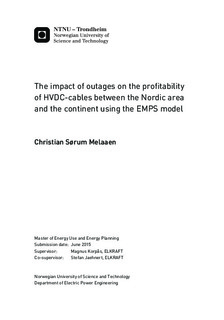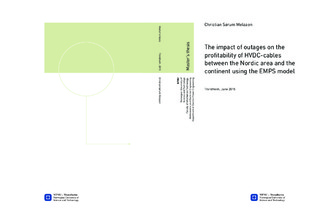| dc.description.abstract | This master thesis investigates sudden HVDC-cable exchange limitations between thermal-based and hydro dominated areas from a market perspective. Thermal-based areas are based on fossil-fired units in combination with large amounts of wind and solar energy. This power production structure resembles Germany.
The power market simulator used is EMPS (EFIs Multi-area Power-market Simulator), which is a well-known simulation tool throughout the Nordic area. The simulation uses historical water inflow and weather measurements for 75 climatic years, giving a wide range of different outcomes. The outage analyses are mainly done in a data set developed by SINTEF resembling the North-European power system configuration in year 2030.
The EU has agreed upon extensive objectives regarding reduction in greenhouse gas emissions. The energy sector is changing towards more Renewable Energy Sources (RES). The challenge is that RES is not able to accomplish the same flexibility as conventional power plants provide. Flexible hydropower production from Norway intends to support intermittence of RES and contribute to security of supply. Exchange capacity from Norway to continental Europe is provided through HVDC-cables. This report shows the impact of HVDC-cable outages on North-European power prices.
Statistical data shows that HVDC-cable disturbance outages occur. Disturbance outages are forced outages limiting the cross-border power exchange. The average cable unavailability due to such outages is 2.4 weeks per year. The cable investigated is the planned cable connecting Norway to Germany, Nord.Link, with a capacity of 1.4 GW. Outages are modelled annually from the beginning of the first week in each simulated climatic year. There is a higher probability of stressed operation in winter time, due to high load combined with lower solar production, and this season is assumed to be a critical period for outages.
The results show that a three-week outage of Nord.Link has close to no impact on the average price in Germany for all 75 simulated years. However, during power capacity shortage, the price increases significantly. Power capacity shortage comes with low wind and solar production combined with high consumption, and demand is met by use of expensive flexible load. It is seen that the highest price in Germany reaches 900 EUR/MWh at worst. This is 200 EUR/MWh higher than if Nord.Link had been available.
German consumers are most affected during outage on Nord.Link. In this study, a three-week outage reduces the consumer surplus in Germany by 60 MEUR in the worst year due to the significant increase in prices. However, the mean loss in consumer surplus for all climatic years is less, being close to 8 MEUR. The results also discover that there is not the outage length that is critical regarding consequences, but the initial power situation in the affected period. A fifteen-week outage of Nord.Link on average costs German consumers 30 MEUR, while a two-week outage during power capacity shortage exceeds 50 MEUR.
The results show that transmission cable outage gives the same consequences in consumer surplus in Germany as power production outage for the same capacity. Additionally, the fault-statistics are in favour of cables. Cross-border capacity should therefore be included in foreign Capacity Remuneration Mechanism (CRM). CRM pays for installed capacity to support intermittence of renewables, making power supply capacity more profitable.
Furthermore, Norway becomes a more secure source of supply in the future due to more interconnections, making it possible to import energy in dry years to store water in reservoirs.
HVDC-cable exchange between the Nordic area and the European continent improves security of supply, and is in line with EUs target of a clean and strongly interconnected power system. The value of providing back-up capacity to the continent is high because the power exchange will reduce continental prices significantly during power capacity shortage, reducing the electricity bill for consumers. | |

